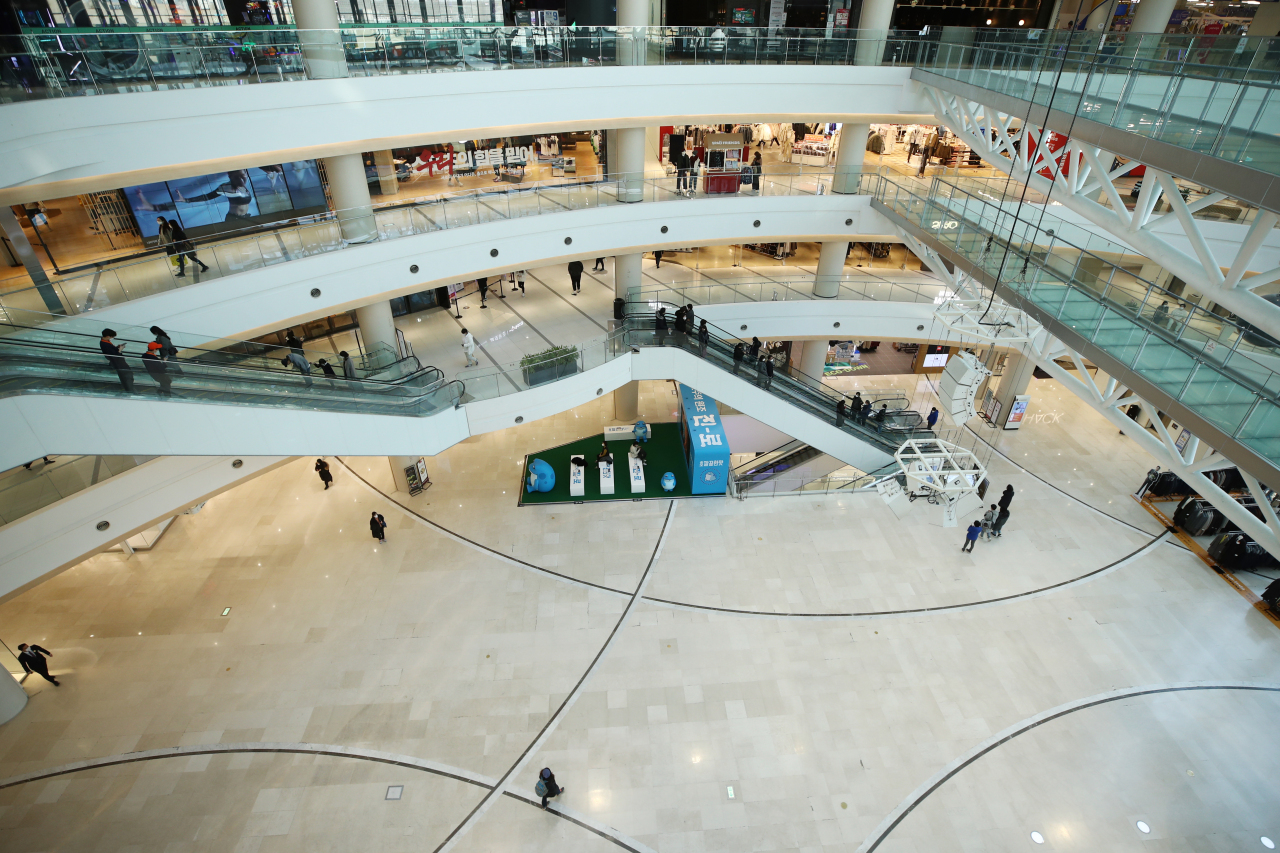
A typically crowded mall in Seoul appears empty on a Wednesday afternoon amid a resurgence in coronavirus cases. (Yonhap)
Government officials said Wednesday that the country would hang on without imposing tougher COVID-19 curbs, reiterating the decision announced Sunday, despite metrics over the last two weeks that indicate South Korea is eligible for the second-strictest tier of its social distancing system.
A total of 22,973 tests confirmed 511 more cases -- 493 locally transmitted and 18 imported -- on Tuesday, according to the Korea Disease Control and Prevention Agency’s situation report Wednesday. The cumulative number of official cases is now 35,163.
From last Tuesday, Korea has been on the middle social distancing tier, which bans indoor dining past 9 p.m. and allows only to-go orders at cafes. Some businesses classified as risky such as karaoke lounges, gyms, bathhouses and theme parks can operate under limited conditions. Indoor gatherings of up to 100 people are permitted.
While measures for mitigating the spread and expanding the capacity of hospitals are yet to come, due to other considerations such as the economy, the government stresses more responsibility on the part of citizens to voluntarily practice social distancing.
“To stem transmission within communities, efforts from the public to stay socially distanced are imperative,” Vice Health Minister Kang Do-tae said in a news briefing. He added that mobile location data showed movement over the weekend has decreased by 23 percent compared with two weeks ago.
Prime Minister Chung Sye-kyun similarly said earlier this week that “now it’s the people who must lead the fight against the coronavirus, by taking everyday steps such as wearing face masks and avoiding crowds and gatherings.”
Contact-tracing regulations have also been strengthened. Submitting contact details is mandatory at most businesses and at all public venues. Noncompliance with contact tracers can result in fines and jail time.
As cases spike and hospitals verge on reaching full capacity, some patients in Busan and North Gyeongsang Province can’t access beds, said the vice health minister in response to a press question. Earlier in Daegu, over 2,000 patients were left waiting for hospital beds at its worst peak. At least two died before they could be admitted.
Occupancy rates at coronavirus hospitals and nonhospital treatment centers were 62.5 percent and 67.4 percent, respectively, as of Tuesday afternoon. The number of severely or critically ill patients was 101, up 20 from a week earlier.
Over the past week, an average of 472 cases tied to community transmission were diagnosed per day. There were 6,572 patients under isolated care as of Tuesday. By 6 p.m. the same day, the number of people placed under quarantine after coming into close contact with a patient has risen to a record high of over 72,026.
As hospitals near crisis, the Korean Medical Association called for the introduction of more stringent measures for at least the next week in a statement issued Tuesday afternoon.
“More intensive physical distancing measures appear necessary at least for the next couple of weeks into December to slow the incidence of infections and ease the burden on health care systems,” said the medical association. The association also warned of a “precarious situation” after the Suneung, when social activities typically increase, and said a greater number of cases could follow the holiday season and year-end celebrations.
The medical association also urged more focus on managing patients who are already infected to reduce the fatality rate and prevent long-term health consequences.
The average time it takes for a patient to recover from a mild case of COVID-19 is 20 days, according to a study by researchers at Kyungpook National University Hospital, but Korea revised the protocols to discharge them faster to make room for new patients.
Since June, patients with mild illness no longer require a negative PCR test in order to be released from care. Previously, two consecutive negative PCR test results from samples at least 24 hours apart were necessary prior to a discharge.
To further ease the strain on intensive care units, the government changed the clinical management guidance in October so that patients on oxygen masks or other low-flow oxygen therapies are no longer classified as having severe cases.
The medical association proposed assigning coronavirus-only hospitals to facilitate patient management.
“As we’ve seen in Daegu, having select medical institutions treat only coronavirus patients is more effective in terms of infection preventions and patient care,” it said, pointing out that under the current system, coronavirus patients were being treated at hospitals as they continue regular appointments and surgeries for non-coronavirus patients.
Some of the country’s top experts have criticized the government’s failure to comply with its own response plan, a softened version of which came into effect in early November.
The new criteria raise the threshold for implementing a stricter tier of social distancing, so that businesses can stay open even when there are higher daily case counts. A lockdown is not among presented options, with the most restrictive tier reserved for when 800 to 1,000 daily cases occur for a week.
Infectious disease specialist Dr. Eom Joong-sik of Gachon University Gil Hospital in Incheon pointed out the government “failed to follow the social distancing playbook as it was laid out upon multiple occasions.”
He suggested that when transitioning from tier to tier, decisions for moving up might need to be made quickly, while easing down to a less strict tier should be slower. “But we’ve been doing the opposite -- fast to lift and slow to impose restrictions.”
By Kim Arin (
arin@heraldcorp.com)

![[AtoZ into Korean mind] Humor in Korea: Navigating the line between what's funny and not](http://res.heraldm.com/phpwas/restmb_idxmake.php?idx=645&simg=/content/image/2024/04/22/20240422050642_0.jpg&u=)
![[Exclusive] Korean military set to ban iPhones over 'security' concerns](http://res.heraldm.com/phpwas/restmb_idxmake.php?idx=645&simg=/content/image/2024/04/23/20240423050599_0.jpg&u=20240423183955)



![[Graphic News] 77% of young Koreans still financially dependent](http://res.heraldm.com/phpwas/restmb_idxmake.php?idx=645&simg=/content/image/2024/04/22/20240422050762_0.gif&u=)